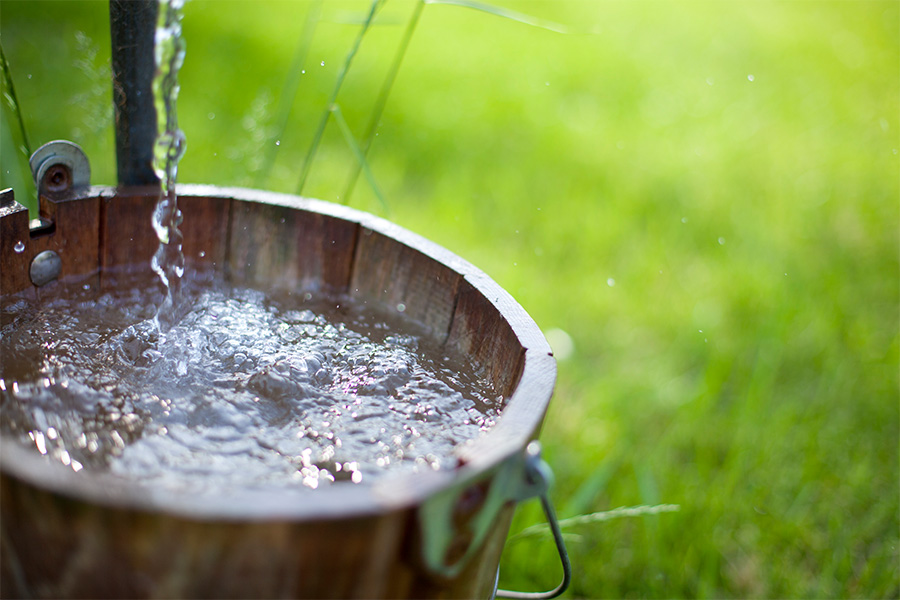Agricultural and Environmental Services Laboratories
-

With growing demands for potable (suitable for drinking) water (due to population increase) and expanding irrigated acreage, there is an increased pressure on irrigated farms to consider using nonpotable alternatives. However, low quality irrigation water can adversely affect soil physical conditions and crop production.
This publication provides in-depth information on the following aspects of agricultural irrigation water quality:
-Importance of irrigation water quality
-Major attributes of irrigation water quality
-Common units used
-Salts content
-Toxicity and their sources
-Bacteria in water sourcesGary L. Hawkins, Stephanie Butcher, Uttam K. Saha, Wesley Porter, and Jason Lessl
|
-

Presence of bacteria in your drinking water supply does not necessarily pose a health hazard. Certain types of bacteria in household water are more of a nuisance issue. Your water may test negative for coliform and E. coli, but it may still contain other bacteria, typically nuisance bacteria. The two most common types of nuisance bacteria are iron (manganese) and sulfur bacteria. Iron (manganese) bacteria are generally more common than sulfur bacteria because large amounts of iron can be present in ground water. Iron and sulfur bacteria can live together in a household water supply system, so it can be very difficult to determine whether the problem is from one or the other, or both.
Water tests looking for the presence of iron bacteria are seldom recommended and are generally not required. Instead, the confirmation of the presence of iron bacteria is usually based on visual inspection. The unmistakable “rotten egg” odor of hydrogen sulfide gas is the most obvious sign of a sulfur bacteria problem.
Once iron bacteria are well established in a household water supply system, their complete elimination is extremely difficult or even impossible. Preventive measures are more critical and effective than corrective actions. This publication includes some simple preventive measures as well as control and treatment options.
John D. Parks, Uttam K. Saha, and Jason Lessl
|
-

Pathogens in household waters pose a serious threat to human health. The CDC has recorded many drinking water microbial-associated disease outbreaks in the U.S., causing illness, hospitalization, and even death. To protect human health, disinfection is considered important in most water treatment systems. This publication provides necessary information on the various disinfection options for household water as well as important points to consider before buying disinfection equipment.
Keith Mickler, Gary L. Hawkins, Pamela R. Turner, and Uttam K. Saha
|
-

Mechanical filtration removes suspended solids and dirt to greatly improve the clarity of water. Various kinds of mechanical filtration methods and devices are available for home water treatments. Primarily, the size of the suspended solids will determine the appropriate type of mechanical filtration device suitable for your unique situation. Consumers interested in filtration devices should discuss the advantages and disadvantages of various available options with a water treatment professional. This publication discusses the various aspects of mechanical filtration.
Gary L. Hawkins, Pamela R. Turner, Uttam K. Saha, and Jason Lessl
|
-

C 858-9
Corrosive or Scaling Water
Corrosiveness or scaling is an inherent property of some groundwater and is related to the type of rocks or sediments in contact with the groundwater. Corrosion is caused when water reacts with and dissolves metal plumbing. This can add toxic levels of metals like copper and lead to your water. Other problems associated with corrosive water include:
• Deterioration and damage to the plumbing
• Water damage caused by leaks
• Staining of laundry
• Bitter taste
• Staining of plumbing fixtures
Scaling occurs when water has high levels of minerals like calcium carbonate, which can build-up on surfaces. Slight scaling can be considered beneficial because the inside surfaces of metal pipes become coated with harmless minerals that act as a barrier to corrosion. Increased levels of scaling, however, can be harmful. Hot-water heaters are the most common place for scale formation in a home water system. Problems caused by scaling include:
• Reduced efficiency of the hot-water heater
• Reduced or blocked flow to fixtures or appliances
• Leaky valves
The degree of either corrosiveness or scaling can be predicted using a Saturation Index (SI). The following information contains a description of the SI, non-treatment strategies for reducing problems, and treatment methods to reduce the corrosion or scale caused by your water.Gary L. Hawkins, Pamela R. Turner, and Uttam K. Saha
|
-

C 858-10
Lead and Copper
Private wells are exclusively supplied by groundwater. The source waters for most public water systems in south Georgia (and some in north Georgia) are also supplied by groundwater. Generally, lead and copper concentrations in the major underground aquifers in Georgia are far below the U.S. Environmental Protection Agency’s (EPA) action levels. They enter the household drinking water system and exceed the action levels almost exclusively via corrosion of plumbing materials. Many homes built prior to the 1988 still have lead solder connecting copper pipes, unless later on replaced by PVC pipes. Also, indoor plumbing fixtures are often made of lead and copper or their alloys, such as brass. Corrosive water can dissolve small amounts of these metals from plumbing which, upon drinking, may be harmful to your health. In 1992, the lead and copper rule, published by the EPA, became effective and required that municipal water suppliers must treat water to reduce concentrations below action levels of 0.015 milligrams (mg) lead per liter or 15 parts per billion (ppb) and 1.3 mg copper per liter or 1.3 parts per million (ppm). Keep in mind, however, that the EPA does not regulate private water supplies (such as well water), nor can the EPA control the lead and copper contamination that may result from your household pipes.
Gary L. Hawkins, Pamela R. Turner, and Uttam K. Saha
|
-

C 858-13
Mercury in Your Water
Mercury in your drinking water poses a threat to your health. The U.S. Environmental Protection Agency (EPA) has set the current standard for mercury in drinking water at 2 parts per billion (ppb). The amount of mercury in public water systems is regulated according to EPA standards. If your water comes from a public system, it is routinely tested to ensure safe mercury levels. However, if you are concerned about mercury levels in your municipal water supply, you should request a consumer confidence report from your water provider or visit EPA’s site at www.epa.gov/ccr. Unlike users of public water systems, those who use private water supplies (such as wells, springs, and cisterns) are responsible for ensuring the quality of their own drinking water. Since private systems are more susceptible to mercury than public water systems, private well owners should take steps to guard their health. Measures include routine testing and wellhead maintenance and protection.
Gary L. Hawkins, Pamela R. Turner, and Uttam K. Saha
|
-

Municipal water systems are required by law to be monitored for many contaminants found in pesticides, solvents, and petroleum products. However, if your water comes from a private well or from a system that serves fewer than 25 people or has fewer than 15 connections, it is not regulated under these laws. The safety of water from these sources is the responsibility of the owners. If you suspect that your water supply may be contaminated, be sure to have your water tested. Contact your county Extension agent for more information. A home water treatment system can help to protect you from certain contaminants in your water supply.
Gary L. Hawkins, Pamela R. Turner, and Uttam K. Saha
|
-

About 95 percent of Georgia’s rural residents depend on groundwater to supply their drinking water and farm needs. Wells are designed to provide clean water. If improperly constructed and maintained, however, they can allow bacteria, nitrates, pesticides, or petroleum products to contaminate ground water. These contaminates can put family and livestock health at risk. This assessment allows you to evaluate the environmental soundness of your farm and operational practices relating to the condition of your drinking water well.
Gary L. Hawkins, Pamela R. Turner, Uttam K. Saha, and Laurel Dunn
|